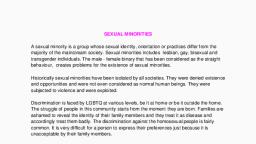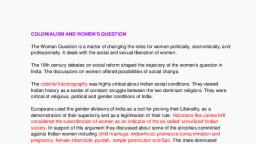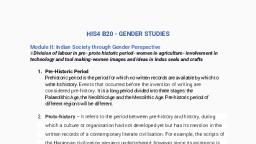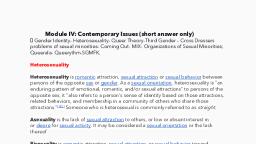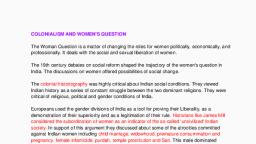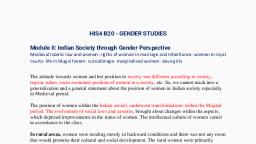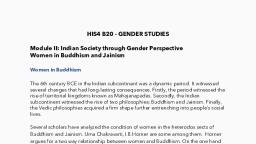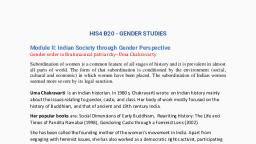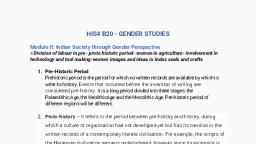Page 1 :
HIS4 B20 - GENDER STUDIES, Module II: Indian Society through Gender Perspective, Gender order in Brahmanical patriarchy- Uma Chakravarty, Subordination of women is a common feature of all stages of history and it is prevalent in almost, all parts of world. The form of that subordination is conditioned by the environment (social,, cultural and economic) in which women have been placed. The subordination of Indian women, seemed more severe by its legal sanction., Uma Chakravarti is an Indian historian. In 1980s, Chakravarti wrote on Indian history mainly, about the issues relating to gender, caste, and class. Her body of work mostly focused on the, history of Buddhism, and that of ancient and 19th century India., Her popular books are: Social Dimensions of Early Buddhism, Rewriting History: The Life and, Times of Pandita Ramabai (1998), Gendering Caste through a Feminist Lens (2002), She has been called the founding mother of the women's movement in India. Apart from, engaging with feminist issues, she has also worked as a democratic rights activist, participating, in several fact-finding committees including the International Tribunal on Justice for Gujarat., She also writes newspaper columns on contemporary issues concerning women and human, rights., Professor Uma Chakravarti, who coined the term in her 1993 paper 'Conceptualising, Brahmanical Patriachy in Early India - Gender, Caste, Class and State' defined brahmanical, patriarchy as 'the need for effective sexual control over women to not only maintain, patrilineal succession but also caste purity, the institution unique to Hindu society'., Brahmanical patriarchy, Brahminical Patriarchy refers to the system under which the caste hierarchy and the gender, hierarchy come together to uphold the Brahminical Social Order, in which upper caste men, socially and economically exert control over people, especially women from the marginalized, cates, The term Brahmanical Patriarchy is essentially an ideology by which the upper castes in India, have ritually, socially and economically marginalized the lower castes and women., Caste and gender, according to Uma Chakravarti, are the organizing principles of the, Brhamanical social order., Why?:- Brhamanical social organization constructed a closed structure to preserve land,, women and ritual quality (caste) within it. These three are linked and applied to organize, and control female sexuality., MAMOC HISTORY, 1
Page 2 :
The honour and respectability of men is protected and preserved through their women., The appearance of puberty thus marks a profoundly 'dangerous' situation and the ritual, related to the onset of puberty indicates the important relationship between female purity, and purity of castes. (GOBJ aandmumicmɔš Gomzamumu GMJh IS ườ), The anxiety about polluting the caste and the quality of the blood through women is best, demonstrated in the horror of miscegeny (varnasamkara). Most polluting are those castes, which are the product of reprehensible unions between women of a higher and men of a, Women are regarded as the entrance into the caste system. The safeguarding of the caste, through female seclusion. Th, threat to upper caste purity is prevented from having sexual access to women of the, higher castes so women must be carefully guarded. (2)m1 vozaulwo nɔomiojno, structure is achie, lower caste ma, whose sexuality is a, According to Uma Chakravarti, Caste and gender hierarchies are the organising principles of, the Brahmanical social order and they are closely interconnected., The formation of 'brahmanical patriarchy' was not a single chronological development. This, article refers to evidence from different regions related to different groups of people located in, specific cultures., Caste, class and gender - the three main elements of the social order in 'early India', which, shaped the formation of brahmanical patriarchy- evolved into a complex structure of, stratification over millennia., The main reason for subordinating upper caste women in 'early Indian society' was the need for, effective sexual control over them. Such control was necessary to maintain 'patrilineal, succession', a requirement in all patriarchal societies; and 'caste purity', an institution unique to, Hindu society., The 'purity of women' is central to Brahmanical patriarchy because the 'purity of caste', depends on it. Restricting the movement of women safeguards the caste structure of Hindu, society. She argues that "...the detailing of norms for women in the Brahmanical texts are a, powerful admission of the power of non-conformist women, or all women who have the power, to non-conform, to break the entire structure of Hindu orthodoxy. For, when women are, corrupted all is lost.", Prof. Chakravarti writes that the shift to an agricultural economy in the post-Vedic period -, between 800 BC and 600 BC- was marked by the emergence of caste and class divisions. This, shift also brought patrilineal succession to kingship and the preservation of caste purity, which, meant closely guarding the sexual behaviour of certain categories of women. A sharp, distinction was made between motherhood and female sexuality, and female sexuality was ".., channelised only into legitimate motherhood within a tightly controlled structure of, MAMOC HISTORY, 2
Page 3 :
reproduction which ensured caste purity (by mating only with prescribed partners) and, patrilineal succession (by restricting mating only with one man).", At this stage, the subordination of women was essential to control their sexuality. They were, represented as innately sinful in ancient literary and religious texts. Prof. Chakravarti also notes, that notions of the 'excessive sexuality of women' were widely prevalent in Brahmanical as well, as Buddhist texts., Chastity and 'wifely fidelity' were idealised as the highest duty of women. This was reinforced, through customs and rituals, and most women internalised and conformed to these norms., Male kinsmen had the authority to coerce and chastise women who violated these norms. The, king articulated the "coercive power of the patriarchal state" by chastising wives who flouted, the ideological norms for women. "Patriarchy could thus be established firmly as an actuality, and not merely as an ideology.", Pathivratha Concept and Streedharma Concept: In the opinion of Uma Chakravarti women's, uncontrolled sexuality was perceived as posing a threat and the narrative and normative literature, of ancient India is thus full of references to the wickedness of women and of their 'insatible' lust., One of the devices by which the mechanism of controlling women is operated through the, ideology called stridharma/pativratadharma. It is the main instrument through which the, patriarchal Brhmanical society subordinated women. They were given schooling in stridharma., This wifely codes/patrivratadharma was internalized by women. Therefore women attempted to, live up to the idealized notions of pativrata., Chastity and widely fidelity are some of the constituents of patrivratadharma. They accepted, stridharma and considered it as the highest expressions of their selfhood. In the opinion of Uma, chkravarti pativrathadharma can be considered as the most successful ideologies constructed by, any patriarchal system., Uma Chakravati opines 'pativrata may be regarded as the ideological purdha of the Hindu, woman.", There are many instances of pativrata ideals in Hindu mythologies., Ramayana created the role models for men and women. There are idealized brothers and sons;, but the most powerful and long lasting of these deals is that of Sita, the long suffering, patient,, loving and faithful wife of Rama. Arundhati could stay the motion of the Sun., Savitiri could win back her dead husband from Yama. Anasuya could transform evil men with, lustful desires into babies. Force by knismen is prescribed to keep woman firmly within the, stridharma. If they are not guarded, stated Manu, they bring sorrow to two families, the one into, which a woman is born and the one into which she is given. Special responsibility in guarding, women is laid upon the husband who is represented as most vulnerable to the loss of his progeny, through the infidelity of women. Law and custom must ensure that women are kept under, the control of patriarchy. The king was vested with the authority to punish errant wives. It shows, that the scriptures advise the use of violence to punish women particularly wives, to make them, conform to the requirements of wifely fidelity., MAMOC HISTORY, 3





